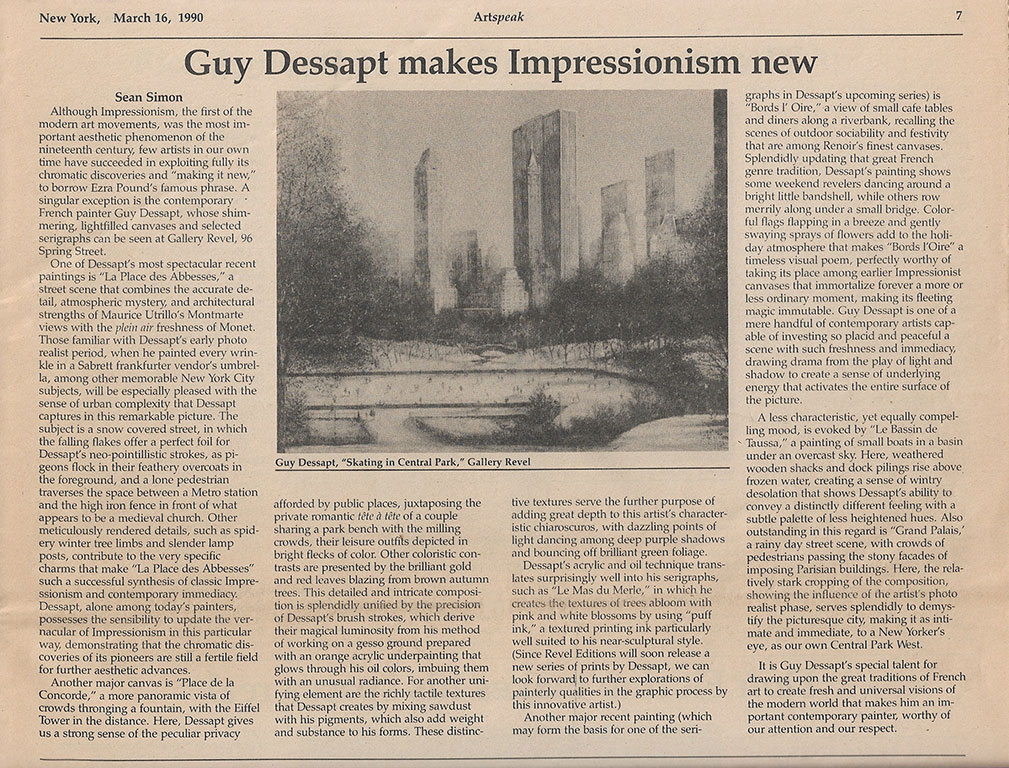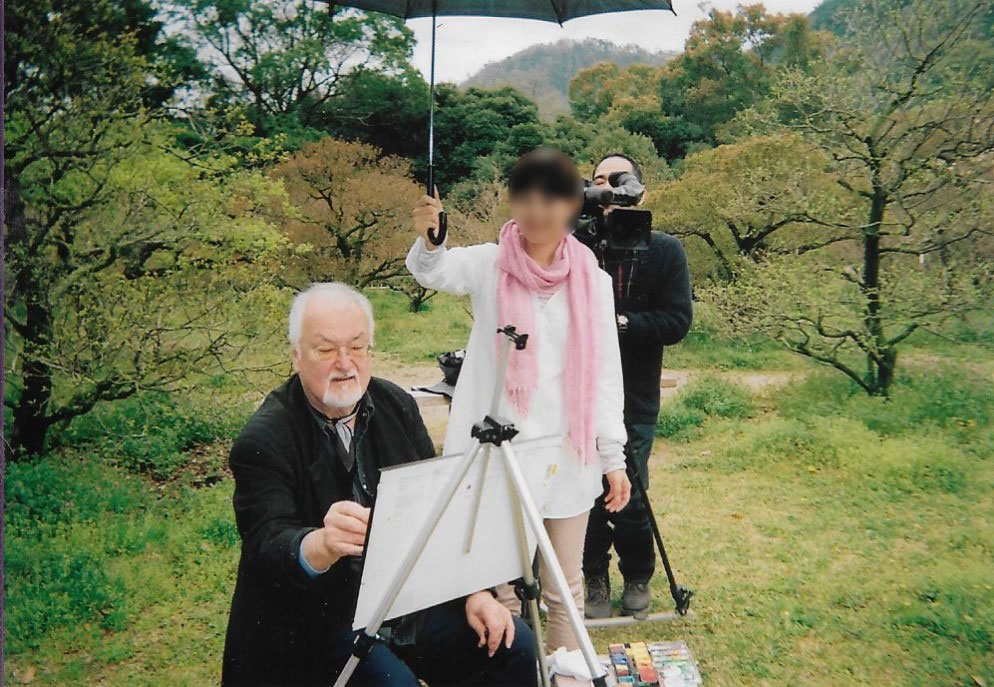
New York, March 16, 1990 – Artspeak
Guy Dessapt makes Impressionism new
Sean Simon
Although Impressionism, the first of the modern art movements, was the most important aesthetic phenomenon of the nineteenth century, few artists in our own time have succeeded in exploiting fully its chromatic discoveries and “making it new,” to borrow Ezra Pound’s famous phrase. A singular exception is the contemporary French painter Guy Dessapt, whose shimmering, light filled canvases and selected serigraphs can be seen at Gallery Revel, 96Spring Street.
One of Dessapt’s most spectacular recent paintings is “La Place des Abbesses,” a street scene that combines the accurate detail, atmospheric mystery, and architectural strengths of Maurice Utrillo’s Montmartre views with the plein air freshness of Monet. Those familiar with Dessapt’s early photo realist period, when he painted every wrinkle in a Sabrett frankfurter vendor’s umbrella, among other memorable New York City subjects, will be especially pleased with the sense of urban complexity that Dessapt captures in this remarkable picture. The subject is a snow-covered street, in which the falling flakes offer a perfect foil for Dessapt’s neo-pointillistic strokes, as pigeons flock in their feathery overcoats in the foreground, and a lone pedestrian traverses the space between a Metro station and the high iron fence in front of what appears to be a medieval church. Other meticulously rendered details, such as spidery winter tree limbs and slender lamp posts, contribute to the very specific charms that make “La Place des Abbesses” such a successful synthesis of classic Impressionism and contemporary immediacy. Dessapt, alone among today’s painters, possesses the sensibility to update the vernacular of Impressionism in this particular way, demonstrating that the chromatic discoveries of its pioneers are still a fertile field for further aesthetic advances.
Another major canvas is “Place de la Concorde,” a more panoramic vista of crowds thronging a fountain, with the Eiffel Tower in the distance. Here, Dessapt gives us a strong sense of the peculiar privacy afforded by public places, juxtaposing the private romantic tête à tête of a couple sharing a park bench with the milling crowds, their leisure outfits depicted in bright flecks of color. Other coloristic contrasts are presented by the brilliant gold and red leaves blazing from brown autumn trees. This detailed and intricate composition is splendidly unified by the precision of Dessapt’s brush strokes, which derive their magical luminosity from his method of working on a gesso ground prepared with an orange acrylic underpainting that glows through his oil colors, imbuing them with an unusual radiance. For another unifying element are the richly tactile textures that Dessapt creates by mixing sawdust with his pigments, which also add weight and substance to his forms. These distinctive textures serve the further purpose of adding great depth to this artist’s characteristic chiaroscuros, with dazzling points of light dancing among deep purple shadow and bouncing off brilliant green foliage.
Dessapt’s acrylic and oil technique translates surprisingly well into his serigraphs, such as “Le Mas du Merle,” in which he creates the textures of trees abloom with pink and white blossoms by using “puff ink,” a textured printing ink particularly well suited to his near-sculptural style. (Since Revel Editions will soon release a new series of prints by Dessapt, we can look forward to further explorations of painterly qualities in the graphic process by this innovative artist.)
Another major recent painting (which may form the basis for one of the serigraphs in Dessapt’s upcoming series) is “Bords de Loire,” a view of small café tables and diners along a riverbank, recalling the scenes of outdoor sociability and festivity that are among Renoir’s finest canvases. Splendidly updating that great French genre tradition, Dessapt’s painting shows some weekend revelers dancing around a bright little bandshell, while others row merrily along under a small bridge. Colorful flags flapping in a breeze and gently swaying sprays of flowers add to the holiday atmosphere that makes “Bords d Loire” a timeless visual poem, perfectly worthy of taking its place among earlier Impressionist canvases that immortalize forever a more or less ordinary moment, making its fleeting magic immutable. Guy Dessapt is one of a mere handful of contemporary artists capable of investing so placid and peaceful a scene with such freshness and immediacy, drawing drama from the play of light and shadow to create a sense of underlying energy that activates the entire surface of the picture.
A less characteristic, yet equally compelling mood, is evoked by “Le Bassin de Taussat,” a painting of small boats in a basin under an overcast sky. Here, weathered wooden shacks and dock pilings rise above frozen water, creating a sense of wintry desolation that shows Dessapt’s ability to convey a distinctly different feeling with a ubtle palette of less heightened hues. Also outstanding in this regard is “Grand Palais,” a rainy-day street scene, with crowds of pedestrians passing the stony facades of imposing Parisian buildings. Here, the relatively stark cropping of the composition, showing the influence of the artist’s photo realist phase, serves splendidly to demystify the picturesque city, making it as intimate and immediate, to a New Yorker’s eye, as our own Central Park West.
It is Guy Dessapt’s special talent for drawing upon the great traditions of French art to create fresh and universal visions of the modern world that makes him an important contemporary painter, worthy of our attention and our respect.
